Submarines
Student Background
Evolution in the design of any vehicle – automobile, airplane or submarine – is often driven by the scientific understanding and available technology of the time. Every vehicle has a purpose and function; and that purpose influences the design of that vehicle. The fleet submarine of WWII was essentially a surface raider which could submerge as a defense mechanism to avoid detection or escape. Its surface operations created the need for a long, narrow profile with a knife edge/shear bow and a flat deck for stability from which to fight deck gun actions. Its maximum speed – 20.5 knots – was on the surface. Submerged it was slow because of the drag created by its shape and underpowered due to the available electric battery technology of the time. Compare this design against the modern nuclear bulbous bow that creates the large and power consuming bow wave on the surface but becomes the efficient profile for underwater operation in excess of 25 knots.
The movement of water over a submarine affects its performance – both its speed and control. Compare the shape of a WWII submarine like the USS Bowfin to a modern submarine like the USS Ohio. What are some of the differences and similarities? For example, the WWII Balao class submarine like the Bowfin has a flat deck while the Ohio is more torpedo-shaped. Which submarine do you think is faster? Will water flow more smoothly over the Bowfin or the Ohio? Why?
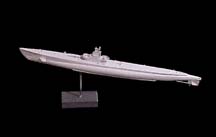
USS Bowfin
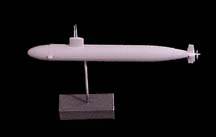
USS Hampton
USS Bowfin and USS Hampton Models Used in the Water Channel Tests
Scientists and engineers refer to a shape that allows air or water to flow smoothly over it as “aerodynamic” or “hydrodynamic.” How do you know if one shape is more aero- or hydrodynamic than another? One way is to place a model of the shape into a water or wind tunnel. Scientists and engineers use a variety of techniques to measure or simply visualize the aero- and hydrodynamics of different objects in these tunnels.
As knowledge and understanding are gained, naval architects, scientists and engineers are able to improve designs. Ultimately, this means safer and faster vehicles.
To commemorate the 100-year anniversary of submarines in the Navy, two different submarine models were tested in a water tunnel at the NASA Ames Research Center – a Baloa class model and an Improved Los Angeles class submarine. The Bowfin is a Baloa class submarine; the USS Hampton is an improved Los Angeles class submarine.
On this site you will learn how submarine designs evolved and that smooth fluid flow reduces the drag on a vehicle. Let’s compare how the flow moves around the Bowfin model and the Hampton model
Water Channel Test of Two Submarine Models
During the water channel tests, photographs and short movies were recorded. The flow is moving from left to right in all of the pictures and movies in this section. Movies 1-3 are taken overlooking the deck of the World War II submarine model (pretend you are in a helicopter looking down at the submarine from overhead). In Movies 4-10, you can see the water flow over the top of the deck and along the bottom of the hull or keel of the WWII submarine model. Movies 11-13 overlook a model of the USS Hampton. As you look at these movies notice how different the flow over a modern submarine looks from the flow over the WWII submarine!
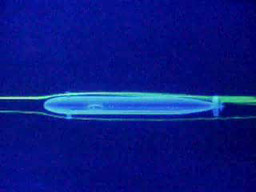
The Flow Moves from Left to Right Over A Modern Submarine Model
Here’s a look at the water tunnel. Water is contained in the large tank on the left, image A (a reservoir) and flows through the channel into a tank at the end of the tunnel, image B. You can’t see it from the pictures but behind the tunnel there is a pump and large flexible pipes. The water is pumped from the lower tank back into the reservoir. The middle of the channel is referred to as the “test section.” This is where the model is attached.
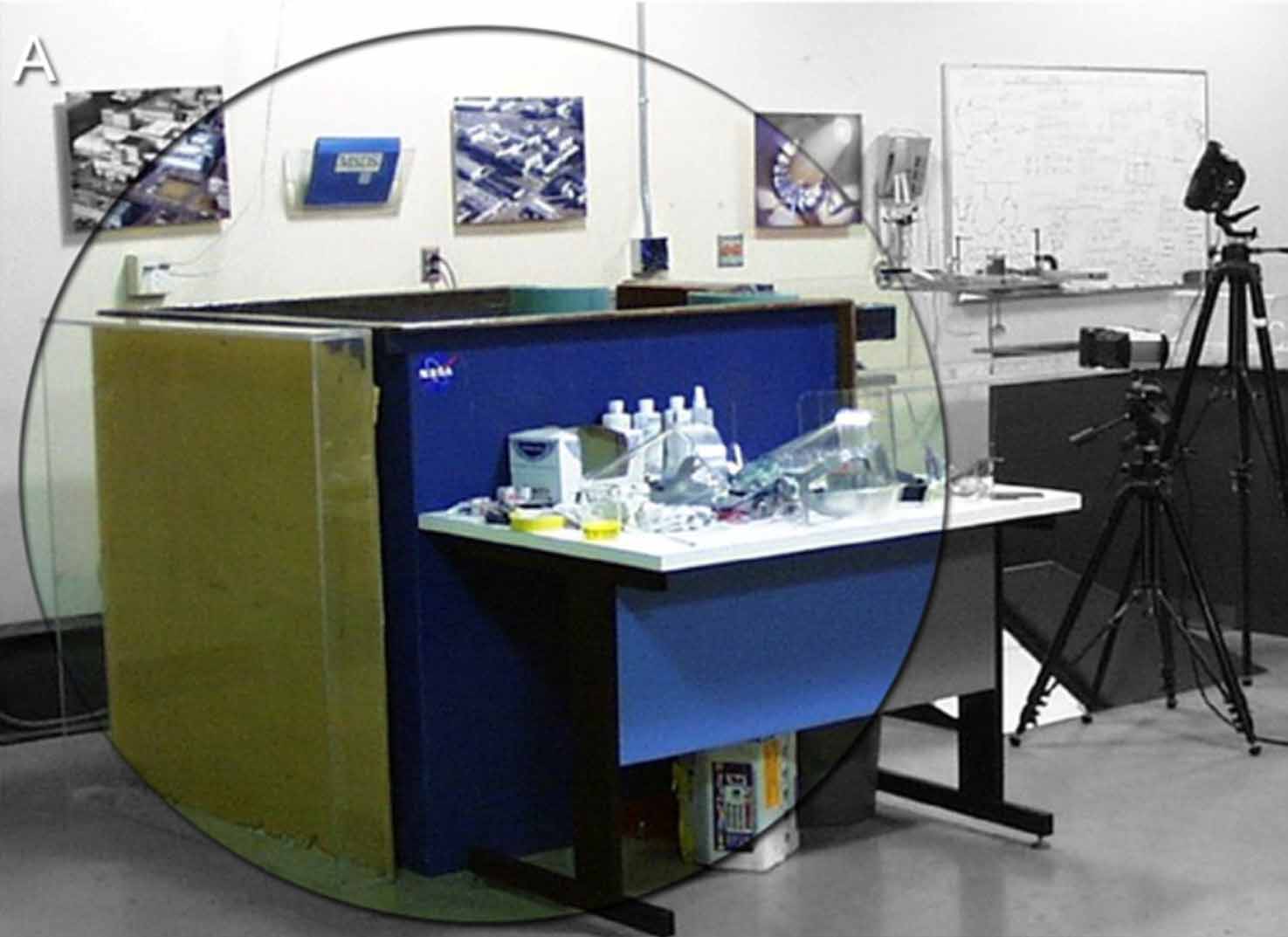
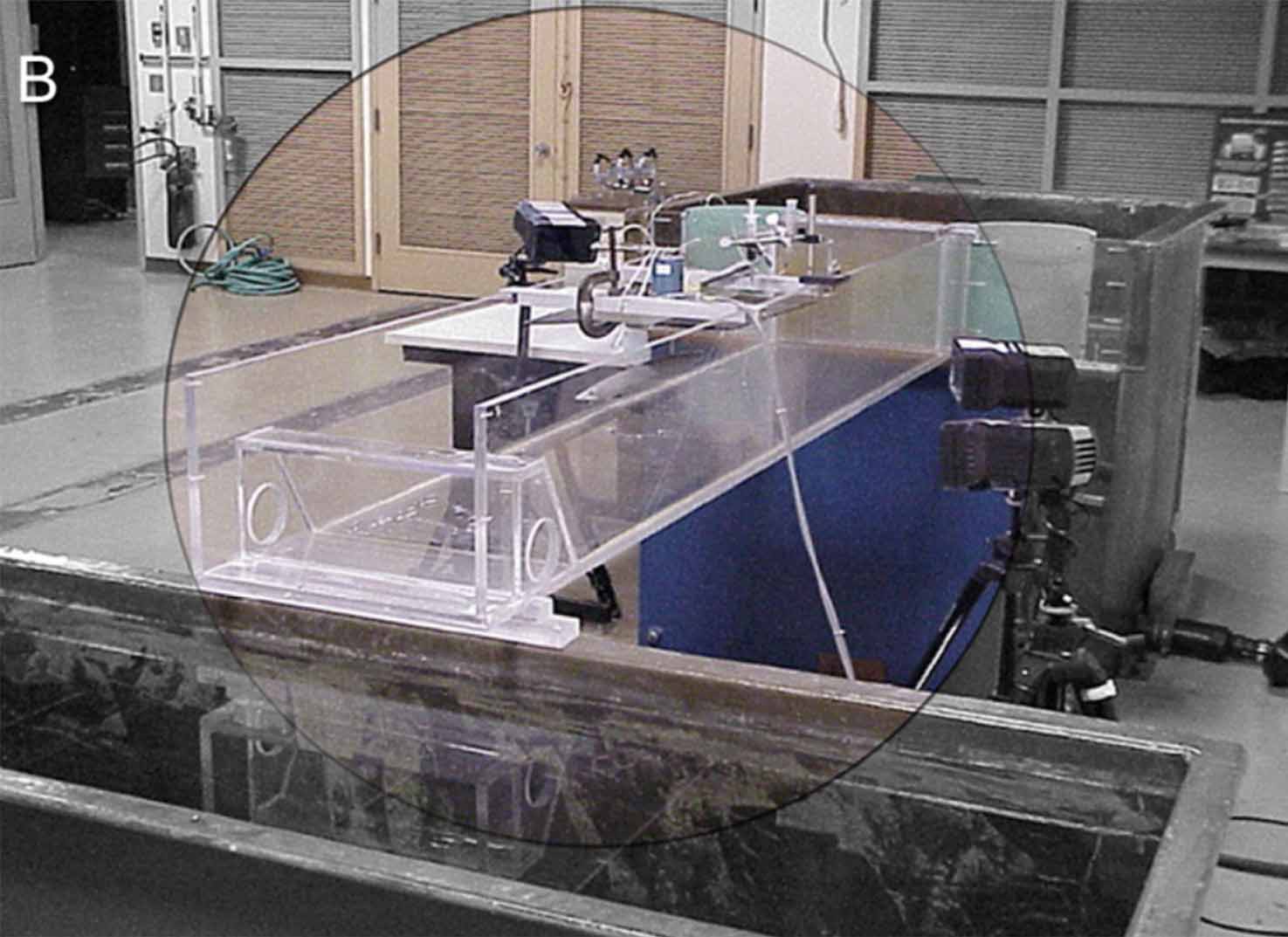
Water Tunnel at NASA Ames Research Center
The test section also contains two small tubes and nozzles. The tubes contain fluorescent dye, which flows through the nozzles. The nozzles are placed so that the dye will pass along the sides of the model. As you can see we used bright yellow dye. As the tunnel is operated the dye is injected into the flow. What do you think happens to the dye? Does it mix with the water?
The dye flows in a fairly straight path. It follows the shape of the submarine. Examine the pictures of the submarines. How are they shaped? They are narrow at the bow, wider in the middle and narrow again at the stern. You can see the bow and stern planes.
Movie 1
Flow Over Sides of the Bowfin Model
The water is flowing from left to right. Notice the dye moving over the model. It does not mix with the rest of the water. The dye flows smoothly over either side of the model following the contour (shape) of the submarine until it reaches the stern of the submarine.
Now, take a closer look at the submarine’s stern in Movie 2. What’s happening? The dye does not flow smoothly along the contour of the submarine – you can see a swirling pattern, called a vortex, at the trailing edge and in the wake (past the stern) of the submarine.
Movie 2
Closeup of Flow Over the Bowfin Model
Movie 3 is a close up of that vortex. Now you clearly can see that the flow was disturbed by small parts on the submarine and created a series of vortices at the trailing edge. Aero- and hydrodynamicists (and now you too!) recognize this pattern as a sign of increased drag (as opposed to a flow with no vortices shed from the surface of an object). Sometimes a sharp increase in drag can be a sign of a potential design problem or that performance can be improved. Even with this increase in drag, the dye flowed smoothly and the flow stayed attached to most of the submarine’s surface quite well!
Movie 3
Closeup of Flow Over the Bowfin Model
Here are a couple of points to keep in mind. The propeller blades are located in front of the stern planes. The propellers on our models did not move. So in real operation, the flow from the propellers would have interacted with the flow moving across the surface of the submarine and developed an entirely different pattern at the stern of the submarine.
Movies 4-6 show the flow moving over the deck and bottom of the submarine. Unlike the sides and bottom of the submarine, which are tapered with smooth curves, the deck is flat with a raised tower as well as guns. This allowed the crew to walk on it and operate some of its defense systems.
Movie 4
Movie 5
Movie 6
Flow Over the Top and Bottom of the Bowfin Model
Closeup of Flow Over the Bowfin Model
Stagnant Area Behind the Tower
The dye flows smoothly across the bottom surface and follows its contour. What happens as the dye moves across the upper deck of the submarine? The dye hits the tower and other structures and separates from the deck in different directions. The flow no longer follows the contours of the deck. This is a sign of high drag or fluid resistance. This is one reason these older submarines were not able to travel as fast as modern submarines. (They also lacked the power since they relied on an electric battery.) In Movie 6 you can see a stagnant area behind the submarine’s tower. The dye is swirling slowly and collecting there in this gap.
Movie 6
Movies 7-10 show the WWII at different angles of attack. Movie 7 shows the flow as the submarine rises to the surface. The flow has separated behind the tower. Movie 8 is a close up of the flow around the submarine’s bow. You can see the flow remained attached even as it moved over the nose of the submarine. Movie 9 shows a close-up of the flow behind the tower. Movie 10 shows the flow at a diving angle of attack. In this direction there were less submarine parts for the dye to bump into.
Movie 7
Movie 8
Movie 9
Movie 10
Bowfin at a Positive Angle of Attack (Rising)
Flow Around the Bow at a Positive Angle of Attack
Closeup of Flow Around the Tower
Bowfin at a Negative Angle of Attack (Diving)
Movies 11-13 are of a modern submarine. Unlike the WWII submarines the modern submarines have a smooth oval shape. There is no flat deck. What do you think the flow will look like over sides of this submarine? The dye is able to flow smoothly across the surface of the modern submarine. There are no vortices oscillating behind the submarine when the submarine is aligned with the flow (moving straight ahead). Movies 12 and 13 were taken as the submarine was turned. Vortices are created as the dye hits the tower.
Movie 11
Movie 12
Movie 13
Flow Over a Modern Submarine
Modern Submarine Turning
Modern Submarine Turning – Closeup of the Flow Around the Tower
MANY THANKS!
The tests were conducted by Kurt Long, U.S. Navy and Dr. Jani Macari Pallis, Cislunar Aerospace, Inc. We wish to thank Jerry, Cliff and Chuck Hofwolt for providing the submarine models; Kurt Long and Dr. Rabi Mehta of the Fluid Mechanics Laboratory at the NASA Ames Research Center Experimental Physics Branch for usage of the water channel to commemorative the 100 year anniversary of submarines in the Navy!
Copyright © 2024 with permission by Cislunar Aerospace, Inc. All Rights Reserved.
